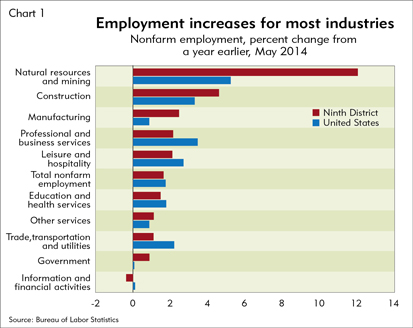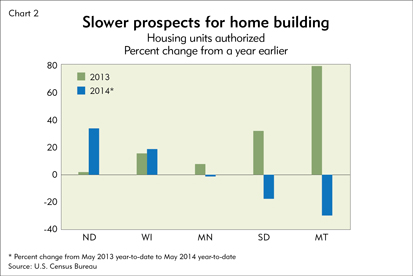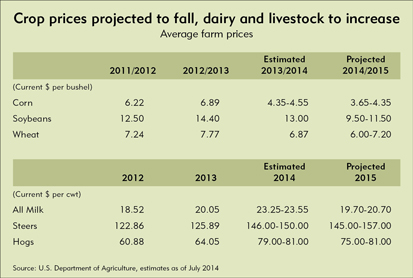The Ninth District is expected to post moderate economic growth during the rest of 2014 and into 2015, according to the Minneapolis Fed’s survey of professional business services firms and the Minneapolis Fed’s economic forecast models. Results from the services survey are more upbeat than the forecast models, which are somewhat less optimistic than forecasts made in January.
Employment has made recent gains, and unemployment rates are relatively low. Residential construction and real estate have softened; whereas, manufacturing has expanded. In agriculture, lower prices are forecast for a number of crops, which will likely reduce income, while livestock and dairy producers are benefiting from higher prices.
That memorable winter
The extraordinarily cold and snowy winter contributed to a slow start to 2014. U.S. GDP decreased at an annual rate of 2.9 percent in the first quarter. However, economic indicators suggest that growth has picked up since the weather turned warmer. The United States gained 282,000 jobs in April and 217,000 in May. During the depth of winter, job growth slowed to 84,000 and 144,000 net new jobs in December and January, respectively.
While residents and businesses in the Ninth District are used to weathering cold and snow, the harshness of this past winter left a few dents in economic activity. Supply and distribution routes were frequently interrupted due to snow, and extremely cold weather slowed visits to some winter tourism destinations in the district. The long winter delayed planting, but farmers have mostly caught up. While year-over-year employment growth slowed in February in several areas of the district, employment growth picked up in May and was 1.6 percent, slightly lower than the U.S. growth rate.
District employment growth in May was strongest for natural resources and mining at just over 12 percent (see Chart 1). Robust oil and gas drilling and production activity in North Dakota continues to add to payrolls and accounts for most of the district’s employment growth in natural resources and mining. As of May, North Dakota accounted for 59 percent of district employment in natural resources and mining. The Bakken and Three Forks formations are producing 1 million barrels of oil daily in North Dakota and Montana, 12 percent of U.S. oil production (see related story).
Construction employment posted the next-largest gain in employment (4.6 percent), followed by manufacturing (2.5 percent) and professional and business services (2.1 percent). Information and financial services was the only sector to lose jobs over the past year, with a 0.4 percent decrease.
With growing employment, unemployment rates continue to decrease or remain at relatively low levels. The district unemployment rate dropped to 4.9 percent in May, the lowest rate since August 2008, during the first year of the Great Recession. North Dakota has the lowest unemployment rate in the country at 2.6 percent. Even the unemployment rate in the Upper Peninsula of Michigan, which typically is much higher than the district rate overall, has dropped below 9 percent and is down more than a percentage point over the previous 12 months. In April and May, the U.S. unemployment rate was 6.3 percent.
Looking ahead, more respondents to the Minneapolis Fed’s recent professional and business services survey expect employment growth (rather than decline) at their companies during the next 12 months. This assessment was even more upbeat than the employment assessment of the previous 12 months.
However, results of the Minneapolis Fed’s economic forecast models point to slowing employment growth (see charts as well as the July 2014 table). Employment growth is expected to finish 2014 near 1 percent in Minnesota, South Dakota and Wisconsin, closer to 2 percent in Montana and 4.6 percent in North Dakota. Employment is expected to decrease in the Upper Peninsula of Michigan. The models point to little change in employment levels during 2015, except for 1 percent growth in Montana and 4 percent growth in North Dakota. Unemployment rates are expected to remain mostly level, except for a 0.6 percentage point drop in Wisconsin and about a 1 percentage point drop in Montana and the Upper Peninsula from 2013 to 2015.
A constraint to employment growth in several areas of the district is slower growth in the labor force and increased tightening in labor markets. Manufacturers in many parts of the district have noted difficulty finding qualified employees to fill open positions, particularly skilled welders and machinists. Respondents to the professional services survey also observed shrinking labor availability over the past 12 months, and they don’t see the situation changing much in the coming year.
Despite tightening in the labor force and predictions of low unemployment rates continuing through 2015, overall wages haven’t pushed up appreciably. Average hourly earnings for district manufacturing workers increased less than 1 percent for the 3-month period ended in May compared with a year earlier. However, more substantial wage gains continue in the North Dakota and Montana energy drilling and production areas, though the pace of wage increases has slowed recently.
According to the forecast models, personal income growth is predicted to increase in 2014 from year-earlier rates in all district states except North Dakota, where personal income growth is predicted to slow to 0.7 percent. South Dakota’s expected 0.5 percent growth follows a slight decrease in personal income in 2013. Modest predictions for 2014 are in large part due to decreases in farm income following declines in commodity prices. In 2015, personal income growth is expected to perk up, with growth rates accelerating in Montana, North Dakota and South Dakota, remaining the same in Wisconsin and decelerating slightly in Minnesota.
Some softening in home building and sales
Solid home building gains in 2012 and 2013 have helped boost the district’s construction industry over the past couple of years. However, growth in housing units authorized across the district slowed during the first five months of 2014 to 6.6 percent from a year earlier and declined in Minnesota, South Dakota and Montana (see Chart 2). The exception was North Dakota, where housing units authorized were up 33 percent.
Real estate markets in some parts of the district also cooled recently, although home prices continue to climb. During the first six months of 2014, Minnesota home sales were down 8 percent compared with the same period a year earlier. Nevertheless, the median sales price was up 6 percent. The mix of homes for sale in the Minneapolis-St. Paul area includes a much smaller proportion of foreclosed and bank-owned homes than just a few years ago, helping to boost home prices. During the first quarter of 2014, the median sales price for existing homes was up 10 percent in Minneapolis-St. Paul, was up 5 percent in Bismarck, N.D., was up 3 percent in Sioux Falls, S.D., and was flat in Fargo, N.D.
Commercial building is expanding at a moderate pace in the district. Multifamily building construction has been growing steadily in several areas of the district. Office and retail vacancy rates in the Minneapolis-St. Paul area have been decreasing over the past few years.
Manufacturing continues to expand in the district. According to a survey of purchasing managers by Creighton University (Omaha, Neb.), manufacturing grew in Minnesota and the Dakotas during the first six months of 2014, with growth accelerating somewhat since the beginning of the year. This is consistent with national data, which show that manufacturers’ orders increased 2.5 percent during the first five months of 2014 compared with a year earlier.
Another late start for district farmers
Last year was a tough one for farm output, which began 2013 with a late spring thaw and heavy rains that prevented farmers from planting crops on time. The growing season in 2014 started out similarly, with planting delayed by an extended harsh winter. However, as the weather improved, crop producers caught up. Planting progress and emergence rates for corn and soybeans in mid-June were close to their 5-year averages throughout most of the district and, in some cases, were further along. The district’s spring wheat crop saw more mixed progress.
The revenue outlook for crop producers is less sunny. The U.S. Department of Agriculture forecasts lower prices for corn, wheat and soybeans this year (see table). For livestock and dairy producers, the outlook is brighter. Prices for cattle are historically high, and hog prices also remain strong; both are expected to climb higher over the next year. However, the run-up in hog prices is due in part to a virus that has killed large numbers of animals, making the picture for hog producers mixed. Milk prices have increased, but are expected to moderate slightly in the year ahead. In addition, lower crop prices are good news for animal product producers, as their feed costs have come down.
Due to lower crop prices, district agricultural producers began 2014 in worse financial shape than in recent years. According to the Minneapolis Fed’s first-quarter (April 2014) agricultural credit conditions survey, 58 percent of respondents reported lower farm income, while only 9 percent reported higher income. Agricultural lenders mostly expect farm profits to fall further in the second quarter of 2014, with 53 percent expecting decreased income and just 8 percent expecting increases. On balance, the outlook for farm household and capital spending is also for decreases.
Joe Mahon is a Minneapolis Fed regional outreach director. Joe’s primary responsibilities involve tracking several sectors of the Ninth District economy, including agriculture, manufacturing, energy, and mining.









